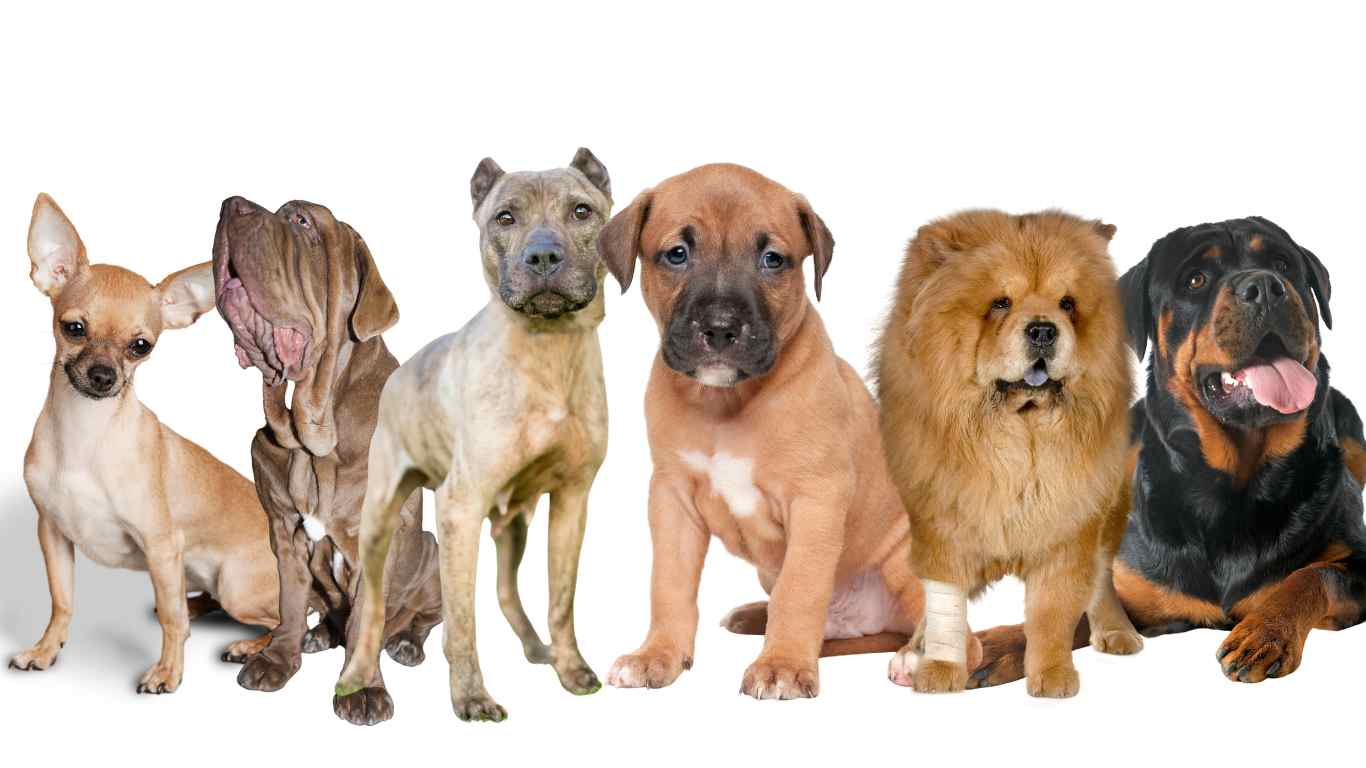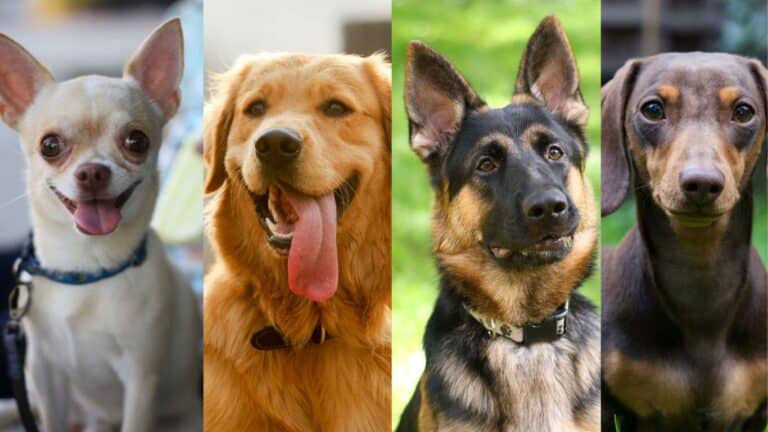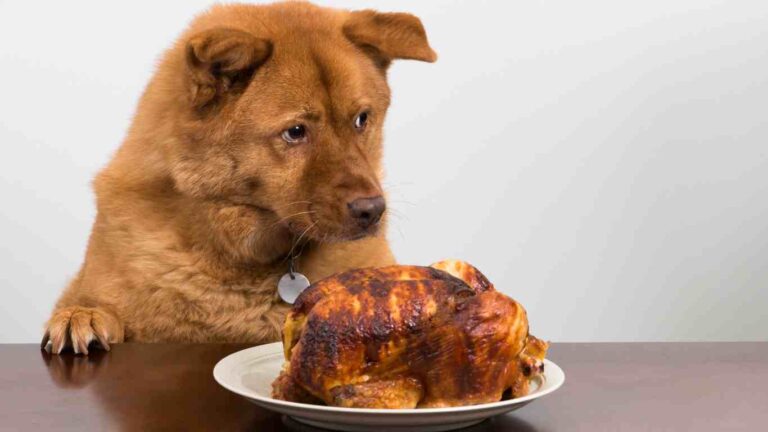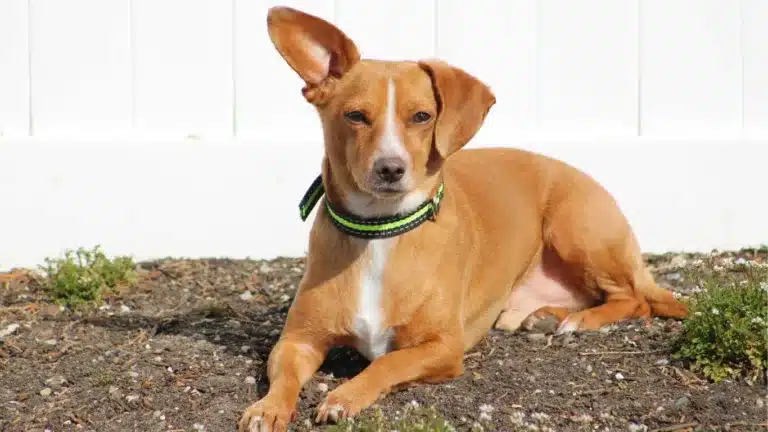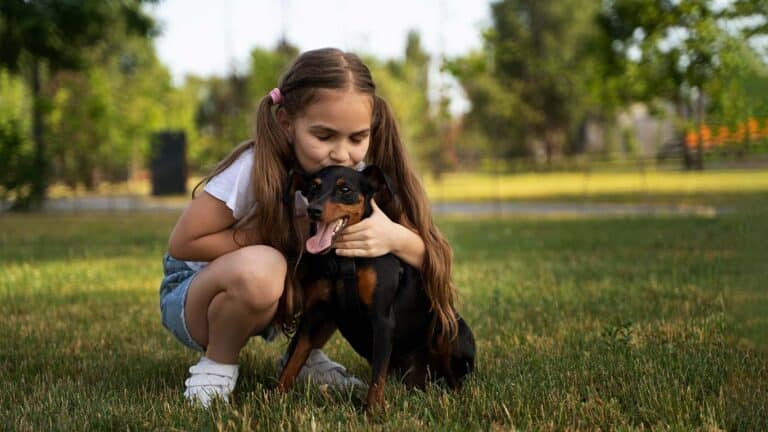Dogs can be loyal companions, but some breeds are known for their aggressive tendencies. Understanding the factors that contribute to aggression can help you interact safely with these dogs. In this guide, we will explore the most aggressive dog breeds based on factual data and provide insights on how to approach them with caution.
Core Insights To Most Aggressive Dog Breeds:
What Makes a Dog Breed Aggressive?
Several factors can contribute to a dog breed being considered aggressive. Genetics, high prey drives, strength, size, trainability, and behavioral issues all play a role in determining a breed’s aggression level. Let’s take a closer look at each of these factors:
- Genetics: Breeds that were selectively bred for guarding, hunting, or fighting purposes may have inherited traits that contribute to aggression.
- High Prey Drives: Aggressive breeds often exhibit a strong instinct to chase and capture prey, which can lead to aggressive behavior toward other animals or even humans.
- Strength and Size: Aggressive breeds are typically larger and more powerful, which can make their aggressive behavior more dangerous.
- Trainability: Some breeds are more difficult to train and control, which can increase the risk of aggression if not properly managed.
- Behavioral Issues: Anxiety, fearfulness, and other behavioral problems can contribute to aggression in dogs, regardless of breed.
Aggression can also be caused by factors unrelated to breed-specific traits, highlighting the importance of considering individual dog behavior and not relying solely on breed stereotypes.
Understanding these factors can help dog owners and enthusiasts responsibly interact with aggressive breeds and take the necessary precautions to ensure safety and wellbeing for both the dog and those around them.
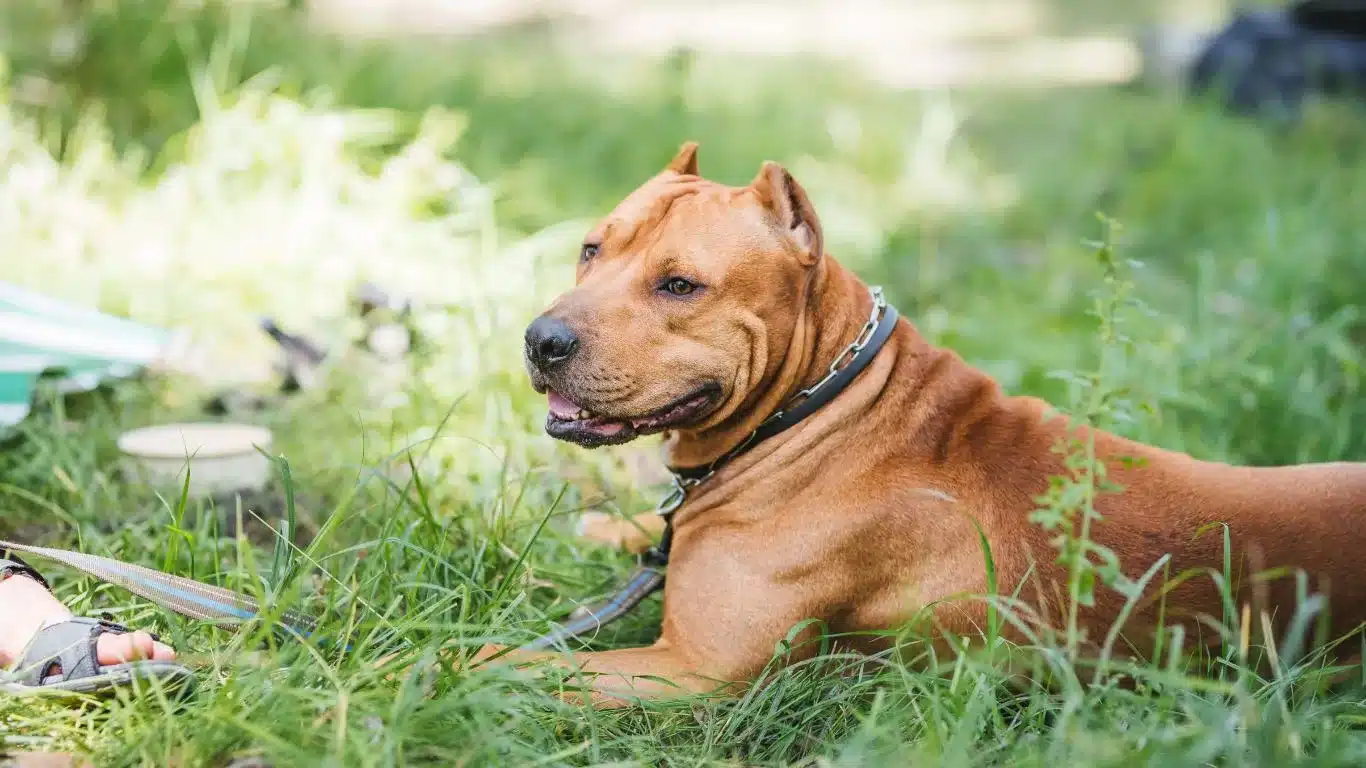
The Role of Genetics
Genetics plays a significant role in shaping a breed’s temperament and behavior. Breeds that were bred for specific purposes, such as guarding livestock or hunting, may have inherited traits that contribute to their aggression. This is particularly relevant when discussing ‘Most Aggressive Dog Breeds.’ For example, breeds like the Doberman Pinscher and German Shepherd, often listed among the most aggressive dog breeds, were initially bred for protection and guarding, making them more prone to aggression in certain situations.
Understanding Prey Drives
Most Aggressive Dog Breeds often refer to a dog’s instinctual desire to chase and capture prey. Aggressive breeds often possess a strong prey drive, which can lead to aggressive behaviors towards smaller animals or even humans. Breeds like the Siberian Husky and Akita, bred for hunting or sled-pulling, may exhibit higher prey drives and require proper training and socialization to manage their aggression.
The Impact of Size and Strength
Aggressive breeds are typically larger and more powerful, which can make their aggressive behavior more dangerous. Breeds like the Bullmastiff and Rottweiler have a lot of physical strength and can cause significant harm if their aggression is not managed. It is crucial for owners of such breeds to prioritize training, socialization, and responsible ownership to ensure their safety and that of others.
Trainability and Behavior
The trainability of a dog plays a crucial role in managing its aggression. Breeds that are naturally stubborn or independent may be more challenging to train and control. Additionally, dogs with behavioral issues such as anxiety or fearfulness can be prone to aggression if not properly addressed. Creating a structured training program and seeking professional guidance can help mitigate aggression in such cases.
Considering Individual Behavior
It is important to note that individual behavior can vary within a breed. Not all dogs of a particular breed will display aggressive tendencies. Factors such as socialization, training, and the dog’s environment can greatly influence its behavior. Responsible ownership and proper training are key in managing aggression and ensuring the safety of both the dog and those around them.
Canine Temperament Testing
Canine temperament testing plays a crucial role in understanding the specific temperament characteristics of dog breeds. One organization that specializes in this testing is the American Temperament Test Society, Inc (ATTS). Their testing methods provide valuable insights for breeders and owners to gain a deeper understanding of a dog’s temperament tolerances and select positive traits.
By assessing a dog’s temperament through rigorous testing, breeders can make informed decisions on breeding programs and work towards eliminating aggressive behaviors. Canine temperament testing helps identify any genetic factors associated with aggression, enabling breeders to make responsible choices that contribute to overall breed improvement.
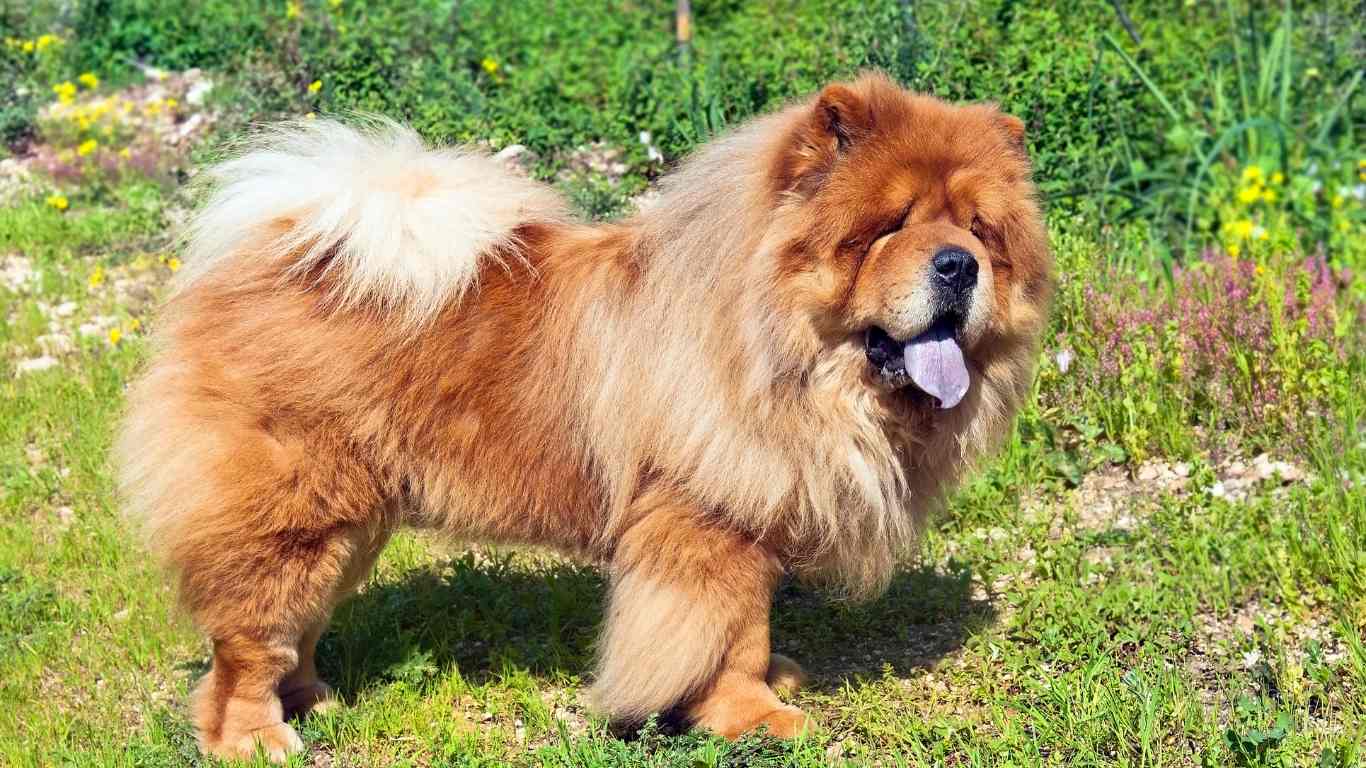
Furthermore, this testing has proven instrumental in training programs, especially when dealing with the ‘Most Aggressive Dog Breeds.’ Understanding a breed’s temperament characteristics helps trainers tailor their training approaches to meet the specific needs of each dog. It allows trainers to address behavioral issues early on and prevent aggressive behavior from developing
Canine temperament testing offers valuable insights for breeders and owners, contributing to the welfare and safety of dogs. It helps identify and select positive traits while working towards eliminating aggressive behaviors and genetic factors associated with aggression.
To provide a holistic view of the benefits of canine temperament testing, the table below highlights some key advantages for breeders, owners, and trainers:
| Breeders | Owners | Trainers |
|---|---|---|
| – Selecting positive traits – Improving breed standards – Eliminating aggression from breeding programs | – Understanding a dog’s temperament – Selecting the right breed for their lifestyle – Nurturing positive behaviors | – Tailoring training approaches – Addressing behavioral issues early on – Promoting well-rounded dogs |
With the insights gained from canine temperament testing, breeders, owners, and trainers can collectively contribute to the well-being and safety of dogs, create better breed standards, and promote responsible dog ownership.
Are Lists of Aggressive Dog Breeds Reliable?
When it comes to identifying aggressive dog breeds, it is crucial to approach popular lists with caution. While these lists can provide a starting point for understanding certain breed characteristics, they may not always be the most reliable source of information. Public opinion and biases can heavily influence the perception of certain breeds, leading to misconceptions and generalizations.
Lists that categorize dog breeds as aggressive often consider factors such as high prey drives, a history of hunting or guarding, or breeds that were selectively bred for fighting. While these factors can contribute to the potential for aggression, it is important to remember that individual behavior can vary within a breed.
Simply relying on anecdotal stories or public opinion to determine a breed’s aggression level can lead to inaccurate conclusions. Each dog is unique and influenced by various factors, such as genetics, environment, and training. It is crucial to consider these individual factors rather than solely relying on broad breed stereotypes.
With selective breeding, certain breeds may have inherited traits that make them more predisposed to aggression. However, it is essential to remember that breed is not the sole determinant of behavior. Each dog should be evaluated based on its own temperament, upbringing, and experiences.
Public opinion and biases can often affect perceptions of certain breeds. Relying solely on anecdotal stories or public opinion can result in less reliable information. It is crucial to consider individual dog behavior and training rather than relying on breed stereotypes.
Recognizing the limitations of aggressive dog breed lists can help promote a more accurate understanding of a particular breed’s temperament and behavior. It is important to base judgments on individual dogs, taking into account their upbringing, training, and interactions.
The Problem with Stereotypes
Stereotypes surrounding aggressive dog breeds can have harmful consequences. These stereotypes can perpetuate fear and misunderstanding, leading to discrimination against certain breeds. It is essential to approach each dog as an individual and provide them with fair and equal treatment.
By focusing on responsible ownership, proper training, and socialization, it is possible to mitigate aggressive behaviors in any dog breed. Building positive relationships based on mutual trust and respect is the key to fostering a safe and harmonious bond with our canine companions.
Remember, it is not the breed alone that determines a dog’s aggression level, but rather a combination of genetic factors, training, and individual temperament.
Chihuahua – Small but Feisty
Chihuahuas, often listed among the ‘Most Aggressive Dog Breeds,’ may be tiny in size, but they have gained a reputation for their aggressive tendencies. Despite their small stature, they are often fiercely loyal and loving to their family members. However, they can display aggression towards strangers and other animals.
Their small size may not make them physically dangerous, but their bites, growls, and relentless barking can still cause harm and create a hostile environment. Proper training is crucial to manage their confidence and prevent aggressive behavior
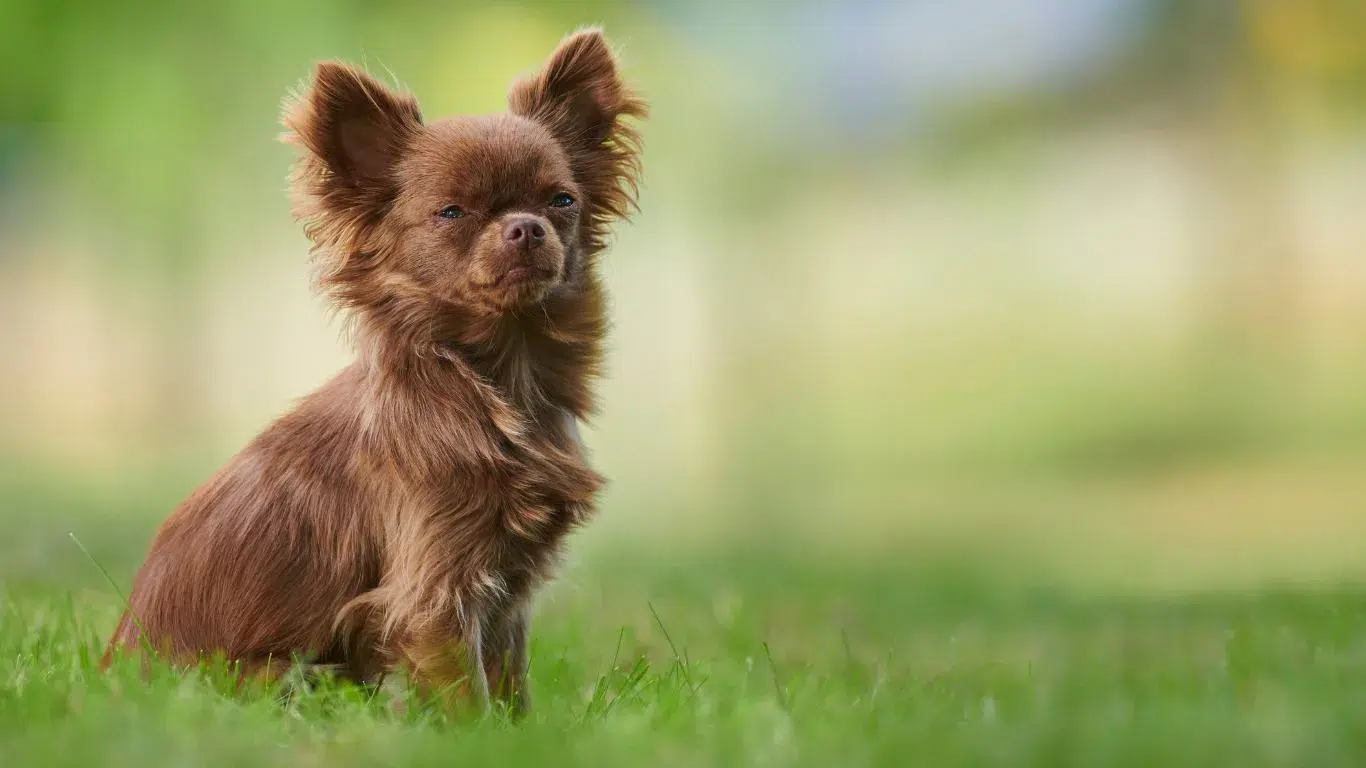
Training Chihuahuas from a young age helps establish boundaries and reinforce positive behaviors. Socialization is key, as it exposes them to various people, animals, and environments, reducing their tendency to react aggressively in unfamiliar situations.
It’s important to note that Chihuahuas’ aggression can stem from fear or insecurity, so creating a safe and secure environment can also help curb their aggressive tendencies. Keep in mind that every Chihuahua is unique, and individual temperament and behavior can vary.
Remember, aggressive behavior in any dog breed can be managed and controlled through proper training and responsible ownership. By understanding Chihuahuas’ tendencies and providing them with the right guidance, you can ensure a harmonious and safe environment for both your Chihuahua and those around them.
Rottweiler – Loyalty with a High Prey Drive
Rottweilers are popular breeds known for their loyalty and protective nature. Their strong bond with their owners often makes them excellent family dogs and guard dogs. However, it’s important to recognize that Rottweilers have natural aggressive tendencies and a high prey drive.
Due to their strength, size, and powerful bites, it is crucial to have firm control and experience in handling Rottweilers to prevent aggression or behavioral issues. Proper training and socialization from an early age are essential to ensure that Rottweilers become well-rounded and obedient companion dogs.
Building a strong foundation of trust and obedience through positive reinforcement techniques can help prevent aggressive behaviors. Rottweilers thrive on consistent training methods that enable them to understand their boundaries and expectations.
Training Rottweilers should focus on teaching them impulse control, proper socialization with humans and other animals, as well as appropriate responses to different situations. By providing consistent guidance, you can mitigate any potential aggressive tendencies and help your Rottweiler become a well-behaved and loyal companion.

Remember, every dog is an individual, and while Rottweilers have a reputation for aggression, proper training and socialization can greatly influence their behavior. Responsible ownership, combined with training techniques that emphasize positive reinforcement and clear boundaries, can help you raise a well-mannered and loyal Rottweiler.
Pitbull Terrier – Controversial Reputation
Pitbull terriers have gained a controversial reputation, with some organizations working to challenge stereotypes of their aggression. They were historically used in dog fighting, giving them a strong bite and protective nature. While individual Pitbulls can be gentle, their breeding and high prey drive can contribute to aggression. Proper care, understanding the breed’s controversy, and training are essential when considering a Pitbull.
| Pros of owning a Pitbull Terrier | Cons of owning a Pitbull Terrier |
|---|---|
| Pitbulls can be loyal and affectionate towards their owners. | Pitbulls may display aggressive behavior towards unfamiliar humans or animals. |
| Pitbulls are generally strong and powerful, making them excellent guard dogs. | Some communities have breed-specific legislation that restricts or bans Pitbull ownership. |
| With proper socialization and training, Pitbulls can live harmoniously with other pets. | Pitbulls require a dedicated owner who is committed to providing structured training and exercise. |
Neapolitan Mastiff – Loyalty and Protection
Neapolitan Mastiffs are known for their loyalty and protective nature. These majestic dogs can be aggressive towards strangers or perceived threats due to their instinctive territorial behavior. With their impressive size and strength, it is crucial to provide them with proper training and socialization to prevent any aggression issues.
Training Neapolitan Mastiffs requires a firm and confident approach. Establishing yourself as the pack leader is essential to control their territorial instincts and prevent aggressive behavior. Consistency and clear commands are vital in their training regimen.
Early socialization is a key factor in managing the aggression tendencies of Neapolitan Mastiffs. Introducing them to various people, animals, and environments from a young age helps them develop confidence and adaptability. This socialization process should be positive and gradual, exposing them to different situations without overwhelming them.
Neapolitan Mastiffs thrive with consistent training methods that focus on positive reinforcement. Utilizing rewards and praise for good behavior helps build a strong bond and trust between the dog and owner.
“The key to managing the territorial behavior of Neapolitan Mastiffs lies in effective training and socialization techniques. By establishing yourself as the leader and exposing them to different situations, you can help them develop balanced and controlled behavior.”
– Dog Training Expert
While Neapolitan Mastiffs have the potential for territorial aggression, it’s important to note that individual temperament can vary. Responsible ownership, proper training, and early socialization are crucial in raising a well-behaved and non-aggressive Neapolitan Mastiff.
| Training Tips for Neapolitan Mastiffs | Key Takeaways |
|---|---|
| Establish firm and confident leadership | Proper training and socialization are crucial |
| Use positive reinforcement techniques | Early socialization helps manage aggression tendencies |
| Expose them to various people, animals, and environments | Individual temperament can vary |
| Provide consistent training methods | Responsible ownership is essential |
Presa Canario – Extreme Territoriality
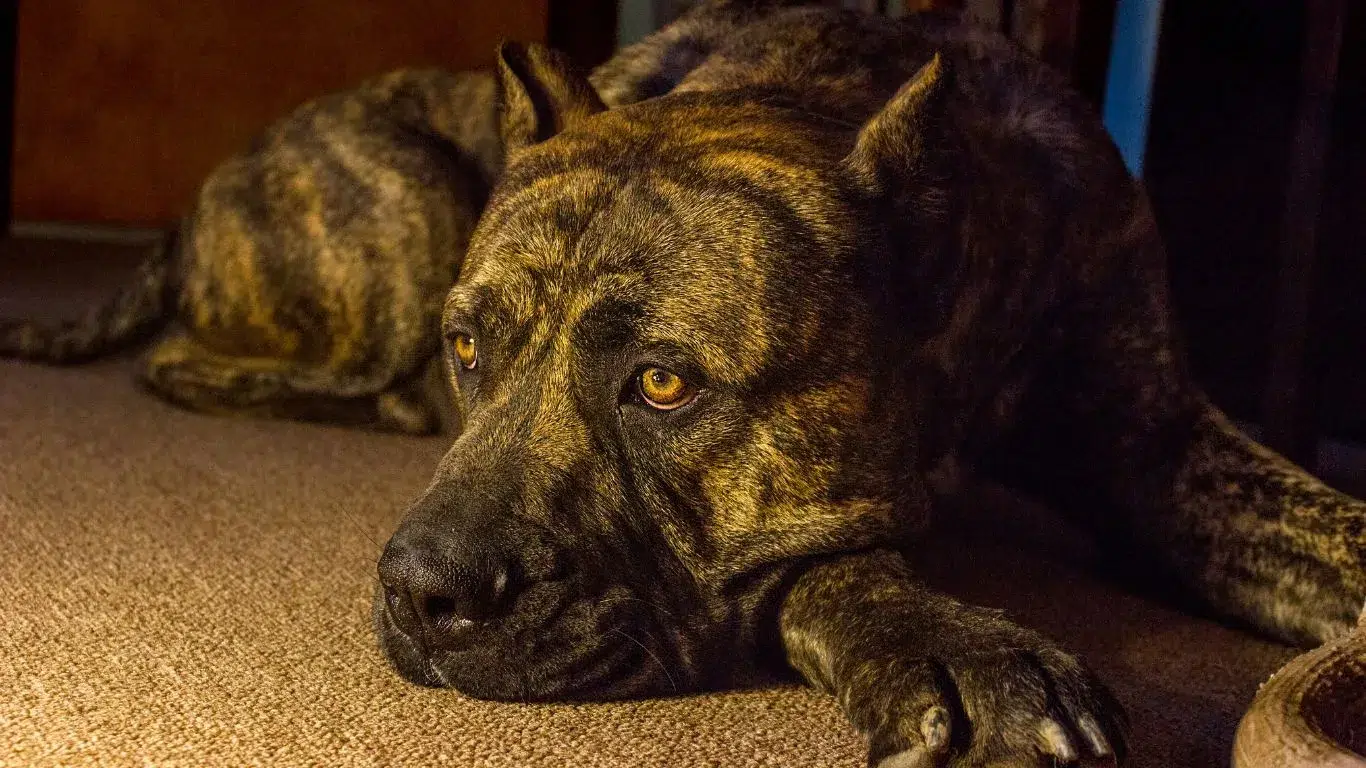
The Presa Canario, also known as the Canary Mastiff, is an aggressive and powerful breed with extreme territorial behavior. Due to their role as guard and fighting dogs, they possess the size, strength, and protective instincts to excel in these roles.
Owning a Presa Canario requires experience in socializing and training to correct aggressive behaviors. Their territorial nature makes them prone to aggression towards both humans and other animals they live with. It is crucial to establish boundaries and enforce proper training to manage their territorial behavior and prevent potential conflicts.
| Traits of a Presa Canario | Territorial Behavior | Training |
|---|---|---|
| Size: Large, muscular build | Distrustful: Highly wary of strangers | Early Socialization: Crucial for managing aggression tendencies |
| Strength: Powerful bite force | Protective: Guards their territory fiercely | Firm Leadership: Consistent commands and assertive training |
| Protective Instincts: Loyalty to family members | Aggression Triggers: Perceived threats to their territory | Positive Reinforcement: Reward-based training methods |
It is essential to establish yourself as the pack leader and provide consistent training and socialization from an early age. Responsible ownership and understanding the breed’s territorial tendencies are necessary to ensure a safe and controlled environment for both the Presa Canario and those around them.
Chow Chow – Aloof and Aggressive
Chow Chows, often included in lists of the “Most Aggressive Dog Breeds,” may appear large and fluffy, but they have a reputation for being aloof and aggressive. Originally bred as guard and hunting dogs, a trait common in the “Most Aggressive Dog Breeds,” they may exhibit high prey drive and territorial behavior. Proper training and consistent commands are necessary to manage their aggressive tendencies. Chow Chows may display aggression towards strangers or other animals they perceive as threats.
Due to their protective nature, Chow Chows require early socialization to ensure they develop appropriate behavior around people and other animals. Training should focus on establishing firm boundaries and reinforcing positive actions. Engaging in obedience classes and consistent discipline can help channel their natural instincts into more desired behavior.
“Chow Chows can be independent and strong-willed, so it’s essential to establish leadership and provide consistent training from an early age. Positive reinforcement techniques work best with this breed.”
When training Chow Chows, emphasis should be placed on teaching them proper socialization and confidence-building exercises. Gradual exposure to different environments, people, and animals can help reduce their aggressive tendencies. Additionally, maintaining a calm and assertive demeanor while setting clear boundaries ensures they understand and respect their owner’s authority.
Table: Aggressive Behavior Management Strategies for Chow Chows
| Training Approach | Description |
|---|---|
| Positive Reinforcement | Use rewards, such as treats and praise, to reinforce desired behaviors and discourage aggression. |
| Consistent Commands | Establish clear and concise commands that the dog can understand and follow consistently. |
| Early Socialization | Expose the dog to various environments, people, and animals from a young age to prevent fear-based aggression. |
| Firm Leadership | Establish yourself as the pack leader and provide consistent guidance to establish boundaries and reinforce discipline. |
By incorporating these training strategies, Chow Chow owners can help manage their aggressive tendencies and create a well-behaved and balanced companion.
Join the Pet Planet Diaries
Sign up for our newsletter to get the latest tips, stories, and exclusive insights into the wonderful world of pets.
Final Remarks
Approaching aggressive dog breeds with caution is essential in order to understand their inherent traits and breeding history. While these breeds may have a reputation for aggression, it’s important to remember that individual behavior can vary within a breed. By providing proper training, socialization, and responsible ownership, you can help mitigate the risks associated with aggression.
Understanding the factors that contribute to aggression is key. Genetics, prey drive, size, and trainability are all important considerations when interacting with aggressive dog breeds. Additionally, being mindful of safety measures can help ensure a harmonious relationship with even the most aggressive dog breeds.
Remember, no matter the breed, responsible ownership and proper training are crucial in preventing aggressive behavior. By providing a loving and structured environment for your dog, you can foster a strong bond and create a positive and safe relationship. With the right approach and precautions, you can enjoy the companionship of even the most aggressive dog breeds.
FAQ
What factors contribute to a dog breed being considered aggressive?
Genetics, including selective breeding for guarding, hunting, or fighting, as well as high prey drives, strength, size, trainability, and behavioral issues such as anxiety or fearfulness, can contribute to aggression in dog breeds.
How does canine temperament testing help determine a dog’s aggression levels?
Canine temperament testing, conducted by organizations like the American Temperament Test Society, Inc (ATTS), provides insights into a dog breed’s specific temperament characteristics. This testing aids breeders and owners in understanding a dog’s temperament tolerances, selecting positive traits, and addressing genetic factors associated with aggression.
Can lists of aggressive dog breeds be relied upon?
Lists of aggressive dog breeds should be approached with caution, as they can be influenced by public opinion and biases. While certain breeds may have higher potential for aggression due to their history or breeding, individual dog behavior and training play a significant role. It is important to consider individual dogs rather than relying solely on breed stereotypes.
Are Chihuahuas aggressive despite their small size?
Chihuahuas are known for being loving and loyal to their family members but can display aggression towards strangers and other animals. Their small size may not make them physically dangerous, but their bites, growls, and barking can still cause harm. Proper training is essential to manage their confidence and prevent aggressive behavior.
Do Rottweilers have a natural aggression tendency?
Rottweilers are popular breeds known for their loyalty and protective nature. However, their natural aggression and high prey drive can pose a risk if not properly trained. Due to their strength, size, and powerful bites, it is crucial to have firm control and experience in handling Rottweilers to prevent aggression or behavioral issues.
Why is there controversy surrounding Pitbull terriers and their aggression?
Pitbull terriers have gained a controversial reputation due to their history in dog fighting, which has contributed to their strong bite and protective nature. While individual Pitbulls can be gentle, their breeding and high prey drive can contribute to aggression. Proper care, breed understanding, and training are essential when considering a Pitbull.
How can aggression in Neapolitan Mastiffs be managed?
Neapolitan Mastiffs are known for their loyalty and protective nature but can be aggressive towards strangers or perceived threats. Their size and strength can contribute to issues without proper training or socialization. Firm training and commands are necessary to control their territorial behavior and prevent aggression. Early socialization is crucial for managing this breed’s aggression tendencies.
What should owners of Presa Canarios know about their territorial behavior?
The Presa Canario, also known as the Canary Mastiff, is extremely territorial and distrustful of strangers. Bred as guard and fighting dogs, they possess the size and strength to excel in these roles. Owners must be experienced in socializing and correcting aggressive behaviors to prevent aggression towards humans and other animals they live with.
Are Chow Chows known for aggression?
Chow Chows may appear large and fluffy, but they have a reputation for being aloof and aggressive. Originally bred as guard and hunting dogs, they may exhibit high prey drive and territorial behavior. Proper training and consistent commands are necessary to manage their aggressive tendencies. Chow Chows may display aggression towards strangers or other perceived threats.
What can be done to mitigate aggression risks in aggressive dog breeds?
While aggressive dog breeds have inherent traits and breeding histories, individual behavior can vary within a breed. Proper training, socialization, and responsible ownership can help mitigate aggression risks. Understanding the factors that contribute to aggression and being mindful of safety measures can ensure a harmonious relationship with even the most aggressive dog breeds.
With a passion for canine companionship and a wealth of experience spanning 15 years, Dan Schroeder stands as a distinguished authority in the realm of dog health, training, and beyond.
From an early age, Dan found solace and joy in the company of four-legged friends, sparking a lifelong dedication to understanding and enhancing the lives of dogs. His journey into the world of canine expertise began over a decade and a half ago, marked by a relentless pursuit of knowledge in the fields of dog health, behavior, and training.

